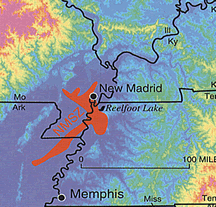Earthquakes
Local Weather via the National Weather Service
Although earthquakes in the Midwest occur less frequently than on the west coast, the threat of earthquake to Missouri residents is high. In the event of a magnitude 7.6 earthquake along the New Madrid seismic zone, Boone County could experience an intensity of VII on the Modified Mercalli Scale.
The earthquakes we've seen around the world in recent years serves as a reminder of the devastation they can create and how we should be prepared. Much of the United States is subject to large magnitude quakes, including the central U.S. which has been the site of some very powerful earthquakes.
According to the Center for Earthquake Research and Information (CERI), over one million earthquakes happen each year. Many of the quakes happen far below the surface the surface of the earth or are too small to be felt. Earthquakes are common natural events.

Some of the strongest earthquakes in U.S. history occurred in 1811 and 1812 near New Madrid, MO. Several of the quakes are estimated to have reached an 8.0 or higher on the Richter Scale and affected more land than any other earthquake on the North American continent. Large areas sank into the earth, new lakes were formed, and the course of the Mississippi River was changed. Fatalities and damage were low, because the area was sparsely settled at that time in our history.
Seismologists predict that the probability for an earthquake of magnitude 6.0 or greater between now and the year 2040 is significant. A quake with a magnitude equal to that of the 1811- 1812 quakes could result in great loss of life and property damage estimated in the billions of dollars. Scientists believe we could be overdue for a large earthquake. Through continued research and public awareness, we may be able to prevent such losses.
Modified Mercalli Intensity Scale
People do not feel any Earth movement.
A few people might notice movement.
Many people indoors feel movement. Hanging objects swing.
Most people indoors feel movement. Dishes, windows, and doors rattle. Walls and frames of structures creak. Liquids in open vessels are slightly disturbed. Parked cars rock.
Almost everyone feels movement. Most people are awakened. Doors swing open or closed. Dishes are broken. Pictures on the wall move. Windows crack in some cases. Small objects move or are turned over. Liquids might spill out of open containers.
Everyone feels movement. Poorly built buildings are damaged slightly. Considerable quantities of dished and glassware, and some windows are broken. People have trouble walking. Pictures fall off walls. Objects fall from shelves. Plaster in walls might crack. Some furniture is overturned. Small bells in churches, chapels, and schools ring.
People have difficulty standing. Considerable damage in poorly built or badly designed buildings, adobe houses, old walls, spires, and others. Damage is slight to moderate in well-built buildings. Numerous windows are broken. Weak chimneys break at roof lines. Cornices from towers and high buildings fall. Loose bricks fall from buildings. Heavy furniture is overturned and damaged. Some sand and gravel stream banks cave in.
Drivers have trouble steering. Poorly built structure suffer sever damage. Ordinary substantial buildings partially collapse. Damage slight in structures especially built to withstand earthquakes. Tree branches break. Houses not bolted down might shift on their foundations. Tall structures such as towers and chimneys might twist and fall. Temporary or permanent changes in springs and wells. Sand and mud is ejected in small amounts.
Most buildings suffer damage. Houses that are not bolted down move off their foundations. Some underground pipes are broken. The grounds cracks conspicuously. Reservoirs suffer severe damage.
Well-built wooden structures are severely damaged and some destroyed. Most masonry and frame structures are destroyed, including their foundations. Some bridges are destroyed. Large landslides occur. Water is thrown on the banks of canals, rivers, and lakes. Railroad tracks are bent slightly. Cracks are opened in cement pavements and asphalt road surfaces.
Few, if any, masonry structures remain standing. Large, well-built bridges are destroyed. Wood frame structures are severely damages, especially near epicenters. Buried pipelines are rendered completely useless. Railroad tracks are badly bent. Water, mixed with sand and mud, is ejected in large amounts.
Damage is total, and nearly all works of construction are damaged greatly or destroyed. Objects are thrown into the air. The ground moves in waves or ripples. Large amounts of rock may move. Lakes are dammed, waterfalls formed, and rivers are deflected.
Intensity is a numerical index describing the effects of an earthquake on the surface of the Earth, on man, and on structures built by man. The intensities shown in these maps are the highest likely under the most adverse geologic conditions. There will actually be a range in intensities within any small area, such as a town or county, with the highest intensity generally occurring at only a few sites. Earthquakes of all three magnitudes represented in these maps occurred during the 1811 - 1812 "New Madrid earthquakes." The isoseismal patterns shown here, however, were simulated based on actual patterns of somewhat smaller but damaging earthquakes that occurred in the New Madrid seismic zone in 1843 and 1895.
Source: The Missouri State Emergency Management Agency
Click the image above to view the full-size Projected Earthquake Intensities Map
Click the image above to view the full-size map of Earthquake Hazards in the Central United States
Additional Resources
To learn more about earthquakes and how to prepare, click on to the links below:
- U.S. Geological Survey (USGS)
- Central United States Earthquake Consortium (CUSEC)
- Center for Earthquake Research and Information -University of Memphis
- Missouri Earthquake History
- DNR publication - The New Madrid Seismic Zone
- State Emergency Management Agency (SEMA) Earthquake Preparedness Info
- USGS Publications for Preparing for Earthquakes
- Earthquake Info for Kids
- Earthquake Hazard in the Heart of the Homeland
- What to do Before, During, and After an Earthquake:


